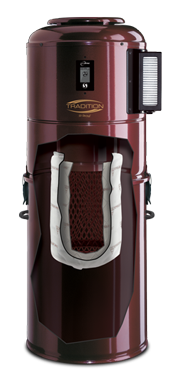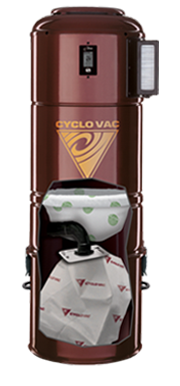Bagged or bagless – why does it matter?
There seems to be a lot of debate – and an awful lot of advertising – about the advantages of bagless vacuum cleaners, with many manufacturers touting the cost savings that come from not having to buy vacuum bags.There’s also the convenience factor – you can just empty the bagless vacuum whenever you want, but in a bagged unit, when the bag is full, and you don’t have a replacement bag handy, you’re stuck.
We’ve been in the vacuum business for over 25 years, and what we can tell you is that in the long run, bagged vacuum systems are less expensive, more convenient, and better for your health. To explain why, we have to tell you a little about how vacuums work. We’re going to talk about central vacuums, but most of this also applies to portable vacuum cleaners.
How does a Central Vacuum work?
The bottom part of your central vacuum system is a large canister that holds all the dust and debris you’ve vacuumed up. When you take off the bottom canister and look inside, the debris is either loose or in a vacuum bag. If you look inside the main unit where the canister was attached, you will see an inlet pipe which connects to your vacuum ductwork. In a bagged system, the vacuum bag attaches to this inlet pipe. In a bagless system, there is no bag on the inlet pipe. Above the inlet duct is a permanent filter, and above that, in the top part of the vacuum housing, sits your vacuum motor.
When you turn on your central vacuum, the motor pumps air out of the canister. Since the canister is sealed, the only place air can enter is through the inlet duct, which is connected to the vacuum ductwork. Air and debris gets pulled through the ductwork and through the inlet pipe into your central vacuum canister, either into a vacuum bag, or just into the bottom canister.
What to do when the canister is full
To empty a bagged central vacuum, you open up the canister, remove and discard the full bag, replace the bag and close the canister. Most people need to do this once or twice a year, and the cost of the bags would be $10-15 per year. With a bagless system, things get a little more complex – and a whole lot messier. Once you remove the canister, you basically have a big bucket full of dust and debris. Where do you put it? Most people empty the waste into a garbage bag, and that often gets messy and dirty, and more than a few times people have told us they’ve gotten a nice lungful of vacuum dust. At this point, most people replace the canister – job done. Or is it?
Remember that permanent filter we mentioned? If you were to look at it now, you would see that it now has a thick layer of dust, and you might have noticed that the vacuum has a lot less suction then when it was new. To clean this filter, what you have to do is bring out another vaccum to clean your Central Vacuum filter. Some of these filters can be removed and washed. While washing this very dirty filter, people at this point are usually starting to think that a vacuum bag would save them 30 rather disgusting minutes and a shower, and are wondering what they ever thought was wrong with spending $10-15 a year on vacuum bags.
A few more things to consider.
Aside from the fact that cleaning a bagless unit is not nearly as easy as the advertisers make it out to be, unfortunately, there are a few more disadvantages that are not always easy to see because they are longer term. That permanent filter – it can trap a lot of the dirt particles, but not all of them. Where do these dust particles go? Firstly, they go back into the air in your garage or utility room (and if you’re using a bagless portable – right back into your breathing air). Secondly, these particles accumulate inside the motor, in the brushes and bearings, reducing the life of the motor unit.
In our experience, with a bagged Central Vacuum, under normal conditions the motor will last around 13 years before needing service, often only requiring a new set of brushes for the motor. With a bagless system, dust accumulates in the motor, and because the motor is straining due to clogged filters, users experience a 40-60% reduction in motor life, requiring service after 7 or 8 years. And here, we’re not looking at just replacing the brushes. Usually it’s the bearings that go, and that means a new motor. In a bagless system, your unit has maximum suction only on day 1. With a bagged system, suction does reduce somewhat as the bag fills, but every time you replace the bag, your unit is restored to maximum suction power.
A little good news
Here’s some good news for owners of bagless systems. Once the novelty and excitement of emptying your own canister has worn off, give us a call. We can actually retrofit many systems, and convert them to bagged.
We always recommend to our customers that they purchase a bagged unit. As you can imagine, people sometimes wonder if we’re recommending a bagged central vacuum so that we can then sell them vacuum bags forever. It’s a little ironic, because in the long run, a bagged system requires fewer service calls. We’d actually be making more if we emphasized bagless systems. Some manufacturers have what are called “hybrid” central vacuums. These can be run either with a bag, or without one, should the need arise. We recommend you always use it with the bag.





Recent Comments